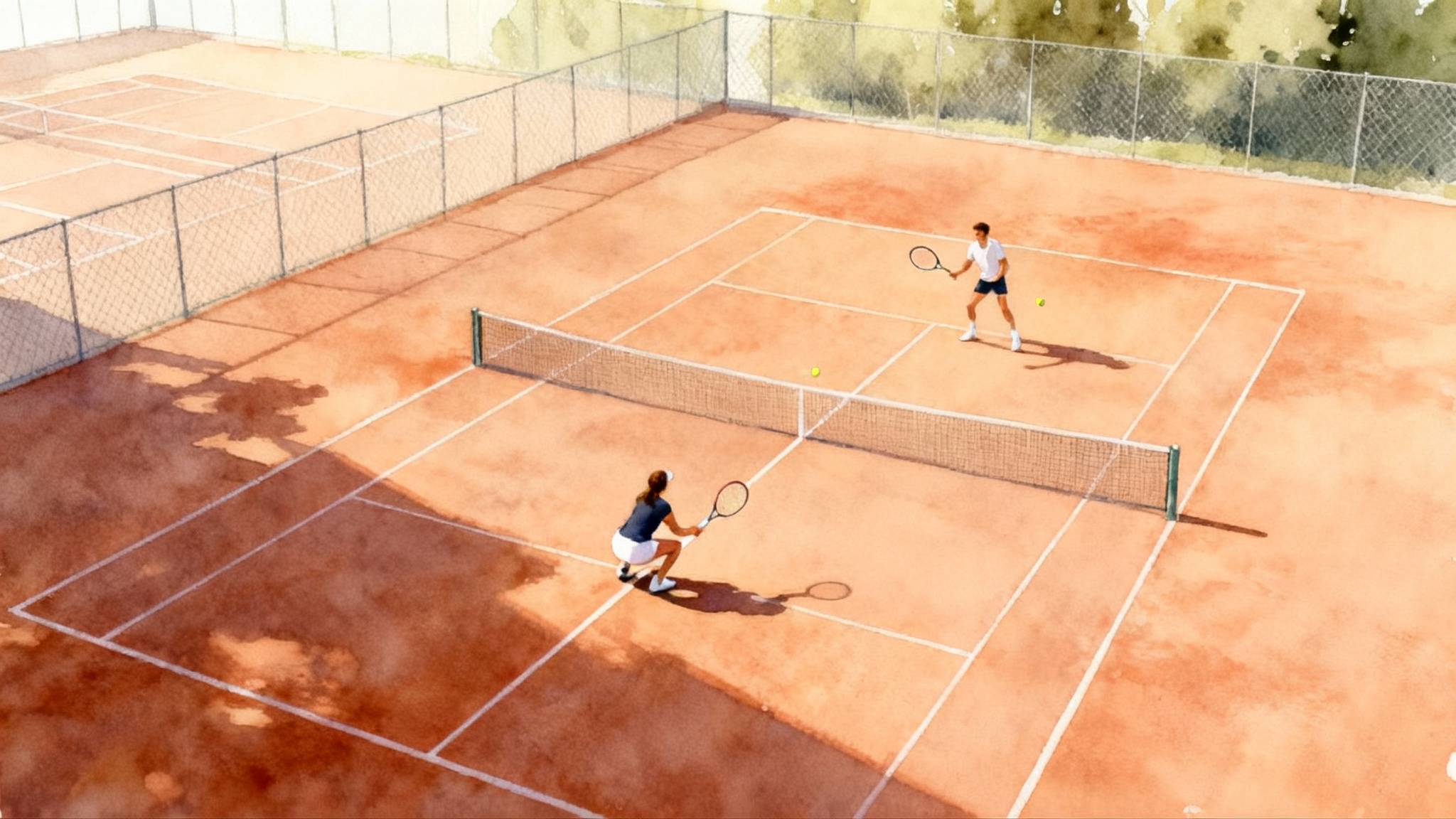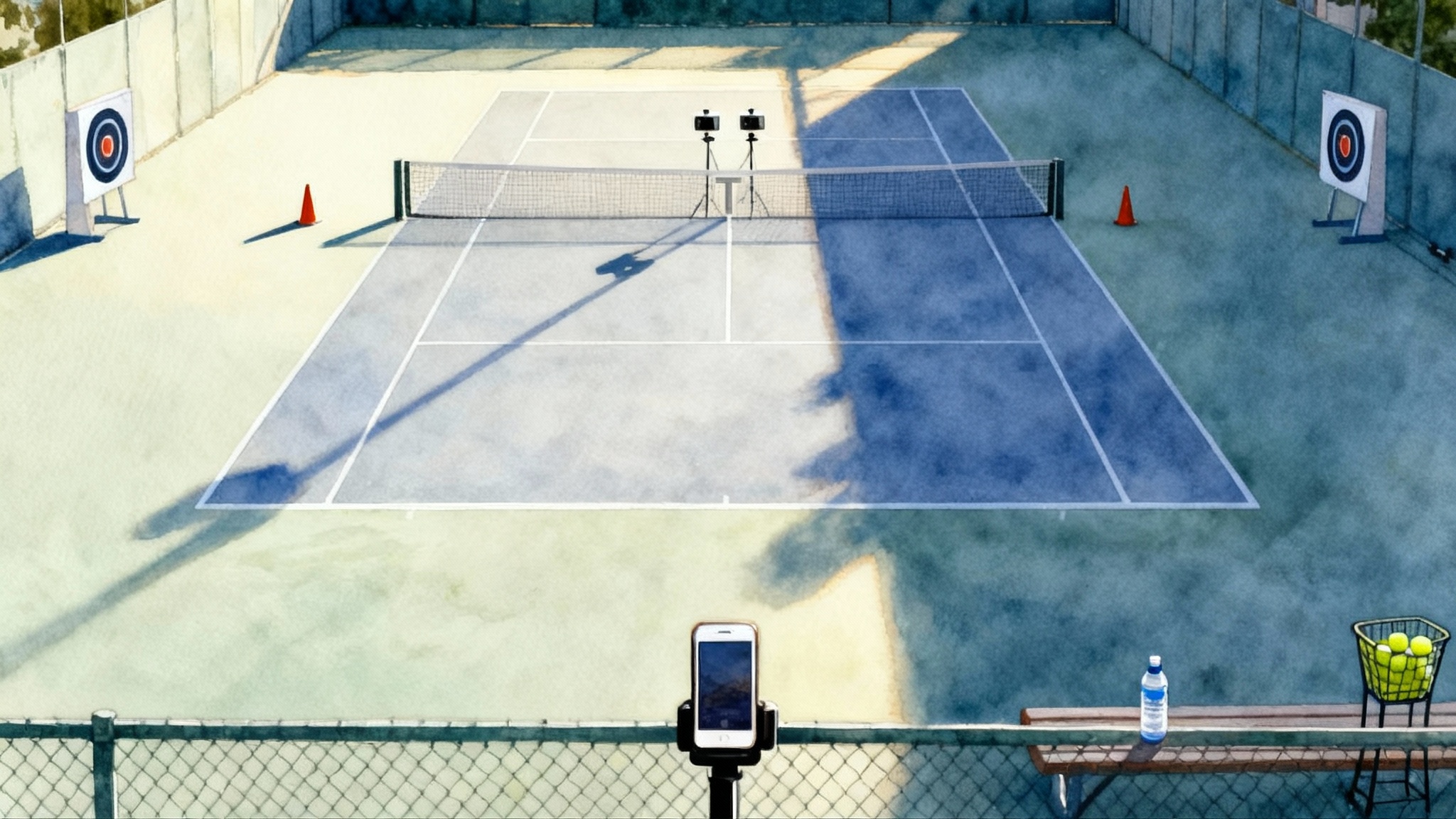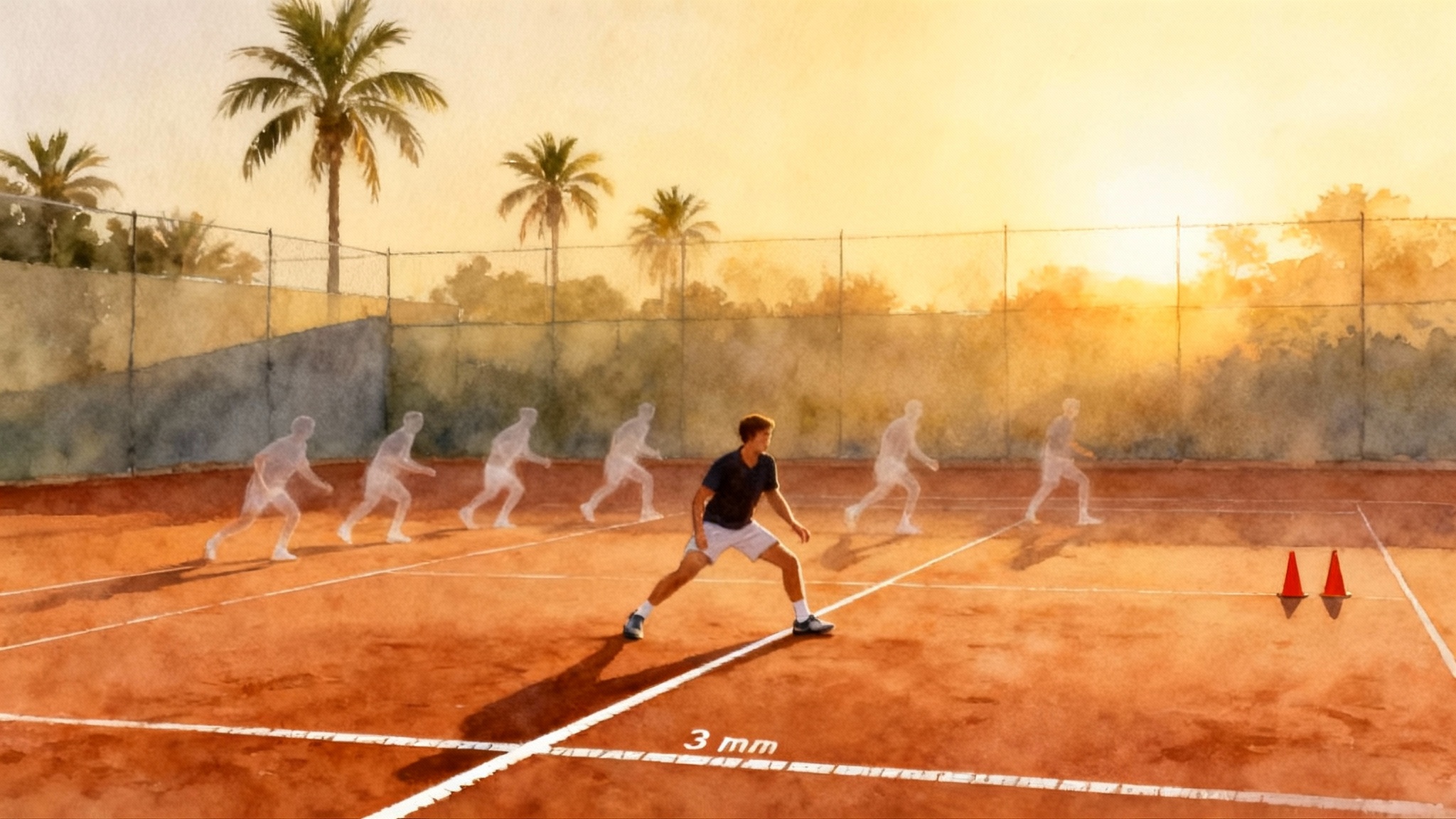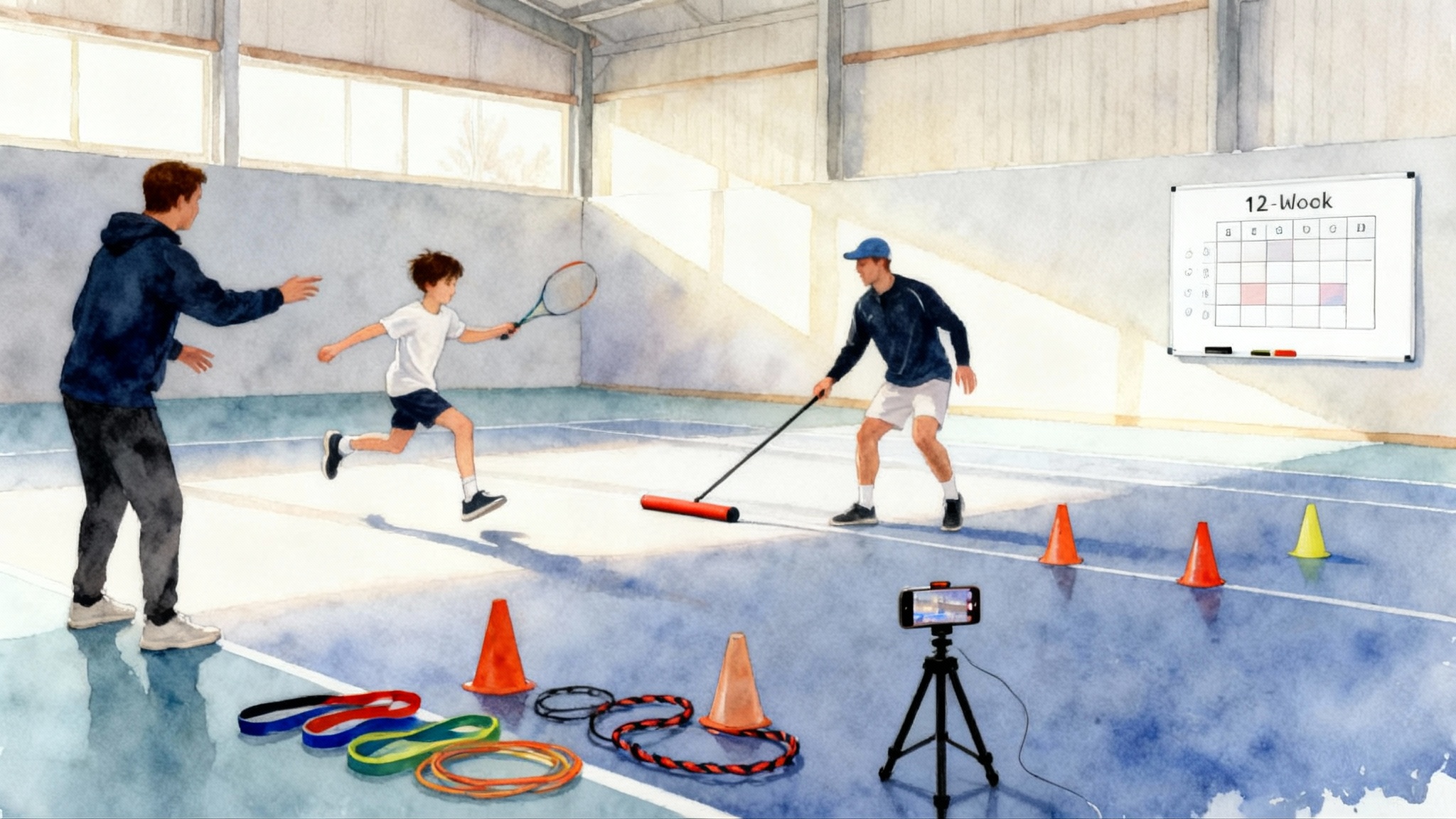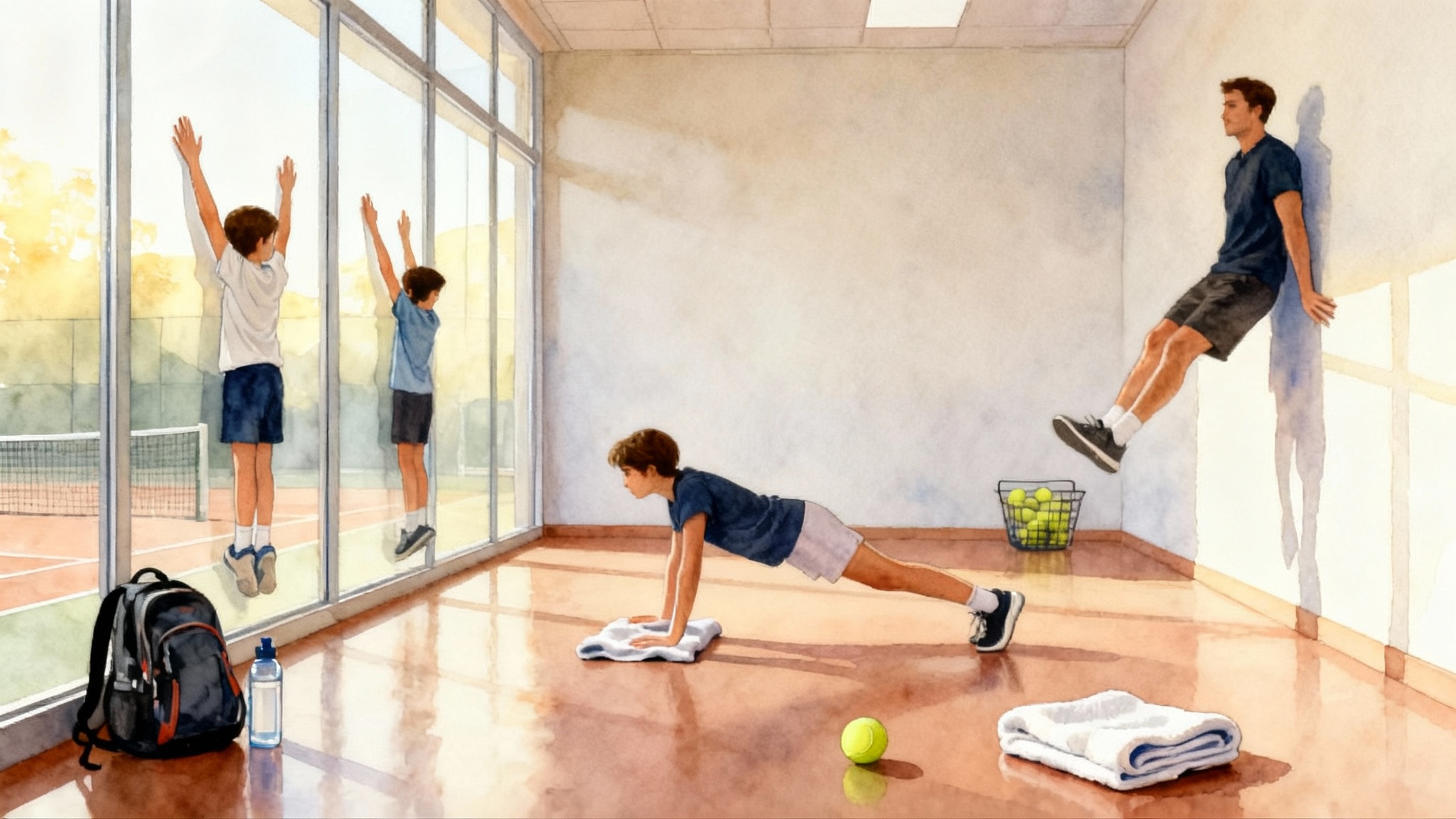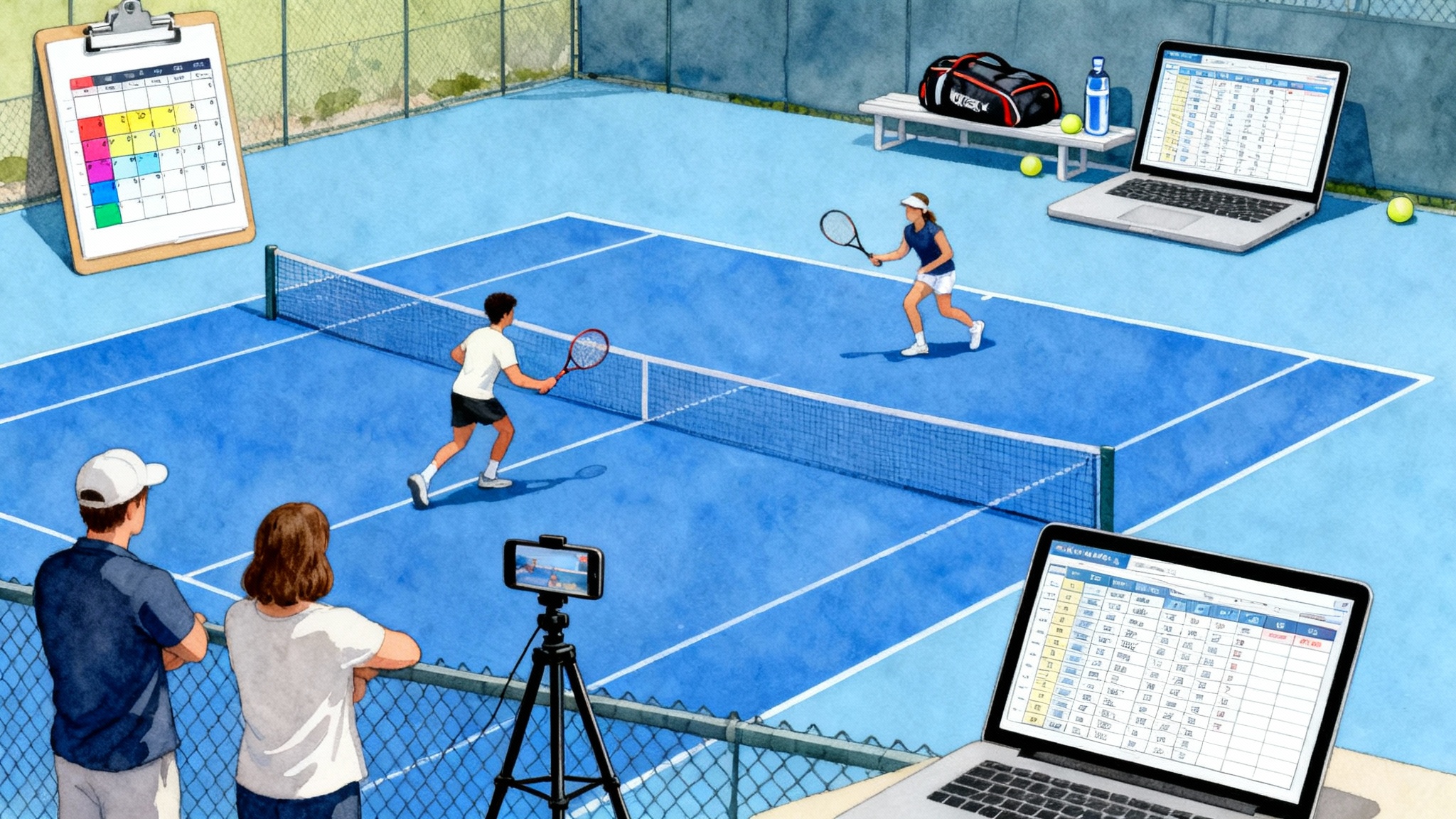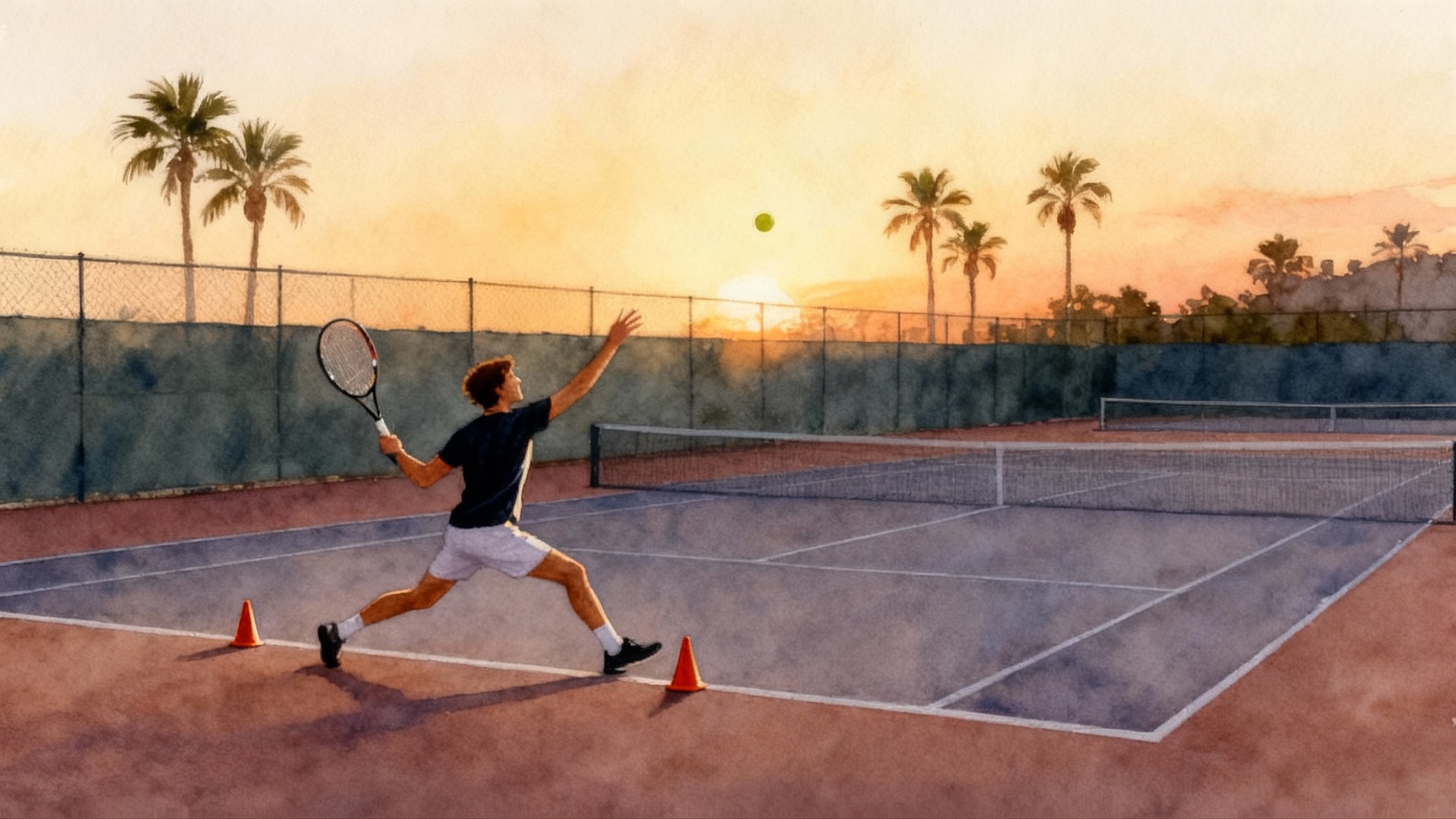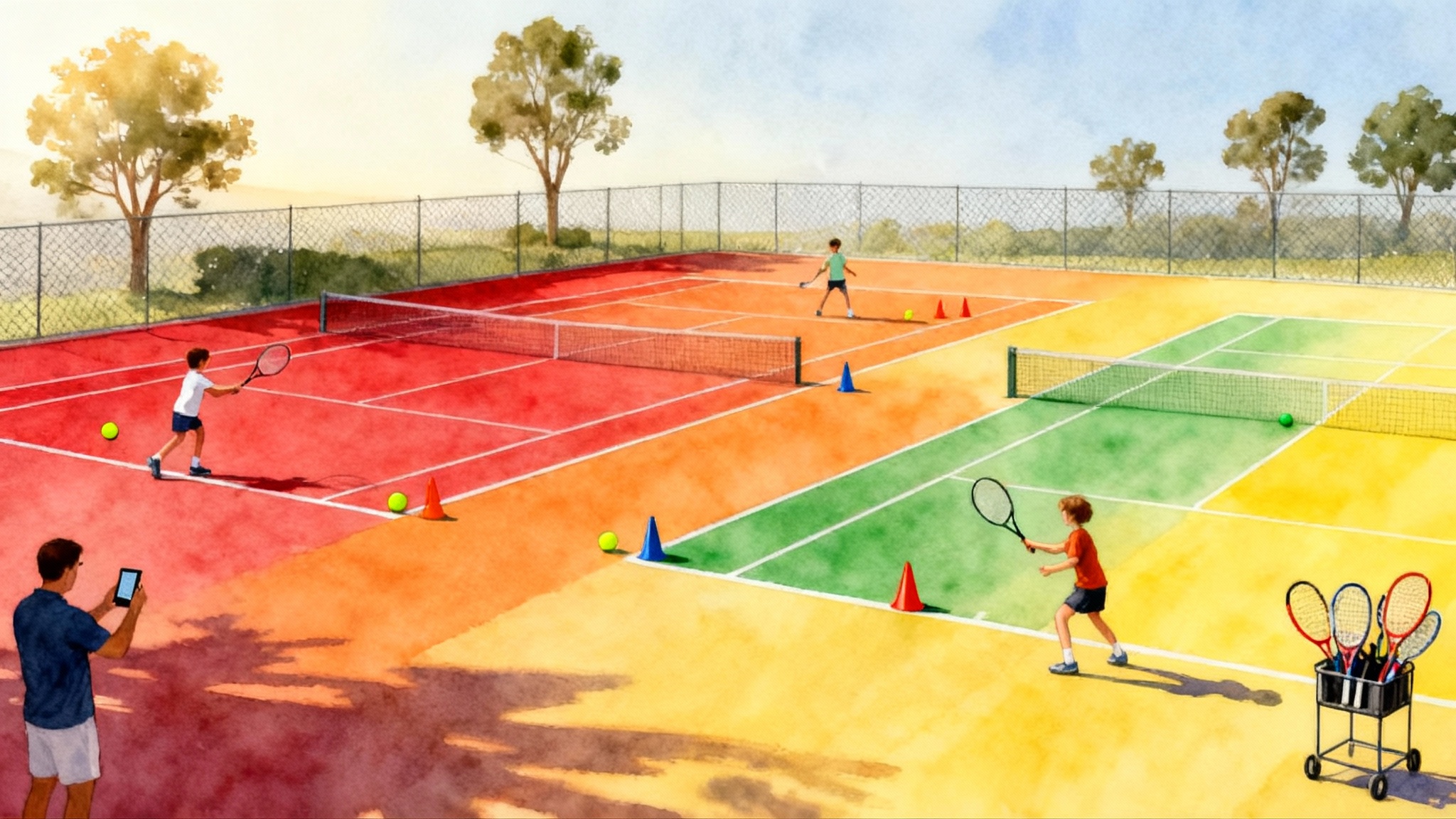In-Season Tennis Strength and Conditioning: 2x/Week for All Ages
Two smart 45 minute sessions per week keep juniors, teens, and adults fast, powerful, and durable in season. Use simple gear, court friendly drills, and quick progress checks. On court or at home options included.
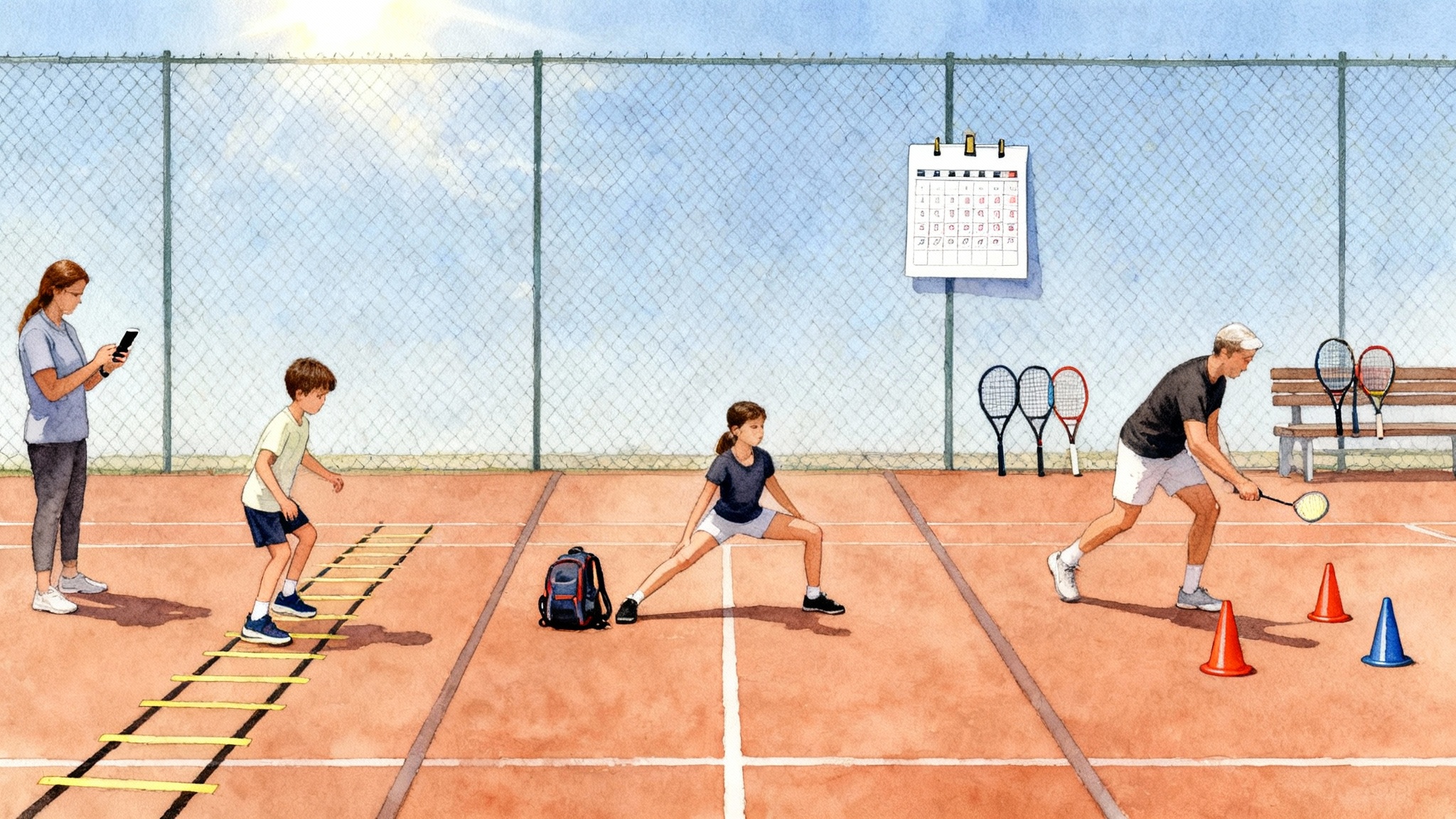
Why two days work in season
You do not need a gym or daily lifting to stay strong and quick once matches start. Two well planned sessions per week are enough to maintain explosive speed, protect joints, and keep footwork sharp. The key is smart structure. Each 45 minute session blends four elements: mobility to prepare the joints, low dose plyometric power to preserve spring, core and hips strength to support strokes and change of direction, and short conditioning to keep point to point stamina without heavy fatigue. This balance protects match performance the next day and builds durability across the season. For on court movement detail, see footwork patterns from split step to shuffle.
If you coach juniors or train as a parent, safety always comes first. Done with proper progressions and volumes, jumping and sprinting are safe for youth and beneficial for coordination. See the NSCA youth training position statement for clear guidance on age appropriate loading and supervision. To keep shoulders and elbows happy through match volume, read our age specific arm care guide.
What you need to start
No racks, barbells, or machines. Gather a small kit you can fit in a backpack.
- Two cones or water bottles to mark distances
- A jump rope or line on the court
- A tennis ball and a mini band
- A phone timer or a simple sports watch from companies like Apple, Garmin, or Timex
- Chalk or masking tape to mark start and finish points
That is it. A standard singles court gives you measured lines and enough space to set up sprints and shuttles.
The simple progress checks
Pick one check per week and log it in your notes app.
- Jump height: three countermovement jumps, hands on hips, measure best of three. Use a wall and chalk to mark reach or record slow motion on your phone and compare takeoff to landing frame counts.
- Ten meter and twenty meter sprint: time from a standing start. Place your phone on the ground as a start beep and have a partner time with a watch. If training alone, use video and count frames. Ten meters shows acceleration. Twenty meters shows top speed for tennis relevant distances.
- Shuttle: two cones ten meters apart. Run down and back once for twenty meters total. Record time. This reflects deceleration and reacceleration.
Retest the same day of the week at the same time. Rest two minutes between trials. Stop if technique breaks down.
The 45 minute template
Each session fits the following structure. Keep rests generous and quality high.
- Warm up and mobility, 8 minutes
- Plyometric power, 8 minutes
- Core and hips strength, 15 minutes
- Court friendly conditioning, 10 minutes
- Reset and breathing, 4 minutes
Below are the exact moves with age specific sets and reps later in the article.
Warm up and mobility
- Skip series for rhythm and posture: forward, lateral, crossovers, 20 meters each
- World’s Greatest Stretch: 2 each side
- Ankle rocks and calf oscillations against the fence: 10 each
- Hip airplane or standing hip rotations holding the fence: 5 slow each side
Plyometric power menu
Choose any two of the following on Session A, then choose the other two on Session B.
- Line hops two feet, forward and back, 3 sets of 10 seconds
- Lateral skater bounds, stick the landing, 3 sets of 4 each side
- Split stance pogos, 3 sets of 10 contacts
- Medicine ball or ball slam against the ground, 3 sets of 5. If no ball, use jump to reach high and land soft
Core and hips strength menu
Pick one hinge, one squat or lunge, and one anti rotation. Use slow lowerings or holds to drive quality with bodyweight.
- Hinge: hip bridge hold, single leg bridge, or tabletop hamstring walkouts
- Squat or lunge: split squat, rear foot elevated split squat with a step, or tempo bodyweight squat
- Anti rotation: suitcase carry with a backpack, plank with shoulder taps, or half kneeling press out with a mini band
Court friendly conditioning menu
Choose one of these for 10 minutes.
- Short shuttle repeats: 10 meters down and back, rest equal to work
- Figure eight around two cones for 15 seconds on, 45 seconds off
- Jump rope steady pace for 30 seconds on, 30 seconds off
Finish with a two minute easy walk on the baseline and two minutes of nasal breathing on your back.
Age specific playbooks
The structure above does not change. Volumes, cues, and exercise choices do. Use the right column for at home options when courts are not available.
Juniors 10 and under
Keep the session playful, short bouts, and technique focused. Use fun cues like tall chin, soft landing, zipper your ribs. Limit total jumps and sprints. For young players, the smaller red, orange, and green court sizes make distance marking easy. The USTA 10 and under guidelines describe the ball and court progressions in clear language.
Session A, 45 minutes
- Warm up: animal walks such as bear crawl and crab walk for 10 meters each, skips and side shuffles
- Plyometric power: line hops two feet for 3 sets of 8 seconds, skater step and stick for 3 sets of 3 each
- Core and hips: hip bridge 3 sets of 15 seconds, split squat to a box or line 2 sets of 5 each, plank on knees 2 sets of 15 seconds
- Conditioning: cone to cone shuttle 8 meters for 6 to 8 reps. Work 8 to 10 seconds then rest 30 to 40 seconds
- Reset: belly breathing with one hand on chest and one on belly for 4 slow breaths
Session B, 45 minutes
- Warm up: dynamic reach with a racquet overhead for balance, ankle rocks
- Plyometric power: pogo jumps in place 3 sets of 10 contacts, jump to touch a fence mark 3 sets of 3
- Core and hips: single leg bridge 3 sets of 10 seconds each side, bodyweight squat 3 sets of 6, half kneeling press out with a mini band 2 sets of 6 each
- Conditioning: figure eight dribble with a ball around two cones for 6 sets of 15 seconds on, 45 seconds off
- Reset: slow nose breathing while lying on the back for 90 seconds
At home swaps
- Use painter’s tape as your line for hops
- Use a couch for split squat depth
- Use a backpack with a few books for suitcase carries if you include them
Progress check for juniors
- Choose jump height every other week. Mark the wall with a removable sticker. Cheer the effort, not the number.
Teens
Teen players can handle slightly higher volumes. Quality still beats quantity. We use tempo and isometrics to build tendon stiffness and control that supports the serve and first step.
Session A, 45 minutes
- Warm up: skips and karaoke for 20 meters each, World’s Greatest Stretch 2 each side
- Plyometric power: skater bounds 3 sets of 4 each side, split stance pogos 3 sets of 12 contacts
- Core and hips: rear foot elevated split squat 3 sets of 6 with a 3 second lower, tabletop hamstring walkouts 3 sets of 6 steps, side plank 2 sets of 20 to 30 seconds each side
- Conditioning: short shuttle 10 meters down and back for 6 to 8 reps. Work 8 to 10 seconds, rest 40 to 50 seconds
- Reset: box breathing for 2 minutes. Inhale 4, hold 4, exhale 4, hold 4
Session B, 45 minutes
- Warm up: ankle and calf oscillations, hip airplanes 5 each side
- Plyometric power: drop squat to stick 3 sets of 3, med ball slam 3 sets of 5. If no ball, jump and reach high with a soft landing
- Core and hips: single leg bridge 3 sets of 10 second holds, tempo squat 3 sets of 6 with a 3 second lower and a 1 second pause at the bottom, anti rotation press out with a mini band 2 sets of 8 each side
- Conditioning: figure eight around cones for 8 rounds of 15 seconds work, 45 seconds rest
- Reset: two minutes easy walk, one minute nose breathing on the back
At home swaps
- Use a sturdy chair as the rear foot support
- Use a folded towel under the back knee for comfort on half kneeling press outs
- Use your phone stopwatch for intervals
Progress checks for teens
- Choose either ten meter sprint or shuttle once per week. Use the same shoes and surface. Log the best of two trials.
Adults
Adult players win in season by staying durable and fresh. We keep jumps lower in number but keep them in the program to hold on to power. We favor isometrics, slow eccentrics, and carries to build tissue tolerance in knees, hips, and lower back without soreness.
Session A, 45 minutes
- Warm up: marching, skips, calf raises 10 each, World’s Greatest Stretch 2 each side
- Plyometric power: low box step off to stick the landing 3 sets of 3 per leg, skater bounds 2 sets of 3 each side with full control
- Core and hips: split squat 3 sets of 6 each side with a 3 second lower, hip bridge hold 3 sets of 20 to 30 seconds, suitcase carry with a backpack for 3 slow trips of 20 meters
- Conditioning: shuttle 10 meters down and back. Perform 6 to 8 reps with 1 to 3 repeat efforts per set depending on match schedule. Rest until you can speak one full sentence comfortably
- Reset: five slow breaths lying on the back, exhale longer than inhale
Session B, 45 minutes
- Warm up: ankle rocks, hip airplanes, side shuffles
- Plyometric power: split stance pogos 3 sets of 10 contacts, reach and touch jump 2 sets of 3
- Core and hips: single leg bridge 3 sets of 10 seconds with a 5 second rest, tempo squat 3 sets of 6 with pauses, plank with shoulder taps 2 sets of 6 per side
- Conditioning: jump rope or step ups at a steady pace 30 seconds on and 30 seconds off for 10 minutes. Keep breathing nasal only if possible to control intensity
- Reset: easy walk for two minutes
At home swaps
- Use a staircase for low step ups
- Use two filled grocery bags for carries
- Use a towel under the knees for floor work
Progress checks for adults
- Shuttle time once per week. Log time and post match soreness on a 1 to 10 scale. If soreness hits 6 or higher, reduce next week’s conditioning volume by 20 percent.
On court versus at home: quick switches
- No med ball available: replace with jump to reach or a rapid racquet swing into a towel for five fast reps
- No cones: use two water bottles or two racquets as markers
- Slippery surface: skip lateral bounds and do split stance pogos and line hops in place
- Neighbors below: swap jump rope for fast marching and quick step over a line
How to mark ten and twenty meters on a court
A standard tennis court measures 78 feet baseline to baseline. Ten meters equals roughly 33 feet. Twenty meters equals roughly 66 feet. You can place one cone a couple of shoe lengths past the service line for ten meters, and a second cone a few steps past the opposite service line for twenty meters. When possible, use a tape measure once and write down your personal landmarks so you can set up in seconds next time. Five long steps is roughly four meters for most adults, so eight long steps is a good first guess for ten meters. Adjust after one measured setup.
Keeping effort in the sweet spot
We use the Rate of Perceived Exertion scale, called RPE. RPE 6 of 10 feels like you could speak in short phrases. RPE 7 of 10 means breathing is heavy but controlled. RPE 8 of 10 is reserved for the last two reps of conditioning if you do not have a match the next day. For in season training, live between RPE 6 and 7. That range sharpens fitness without stealing from tomorrow.
Plug and play calendars that fit real schedules
Choose the calendar that matches your family’s week. If you have a tournament, shift the sessions but keep the two day rhythm. If your season just ended, build your base with our off season 12 week base build.
Calendar A, common for academy clinics on Monday and Wednesday and match play on Friday
- Monday: clinic or lesson. Optional recovery walk 20 minutes in the evening
- Tuesday: Session A
- Wednesday: clinic or live ball. Keep it light
- Thursday: Session B
- Friday: match play night
- Saturday: off or very easy mobility, 15 minutes
- Sunday: family day and optional 20 minute walk
Calendar B, matches on weekends
- Monday: Session A
- Tuesday: clinic or lesson. Keep conditioning easy
- Wednesday: off or 15 minute mobility and a few bridge holds
- Thursday: Session B
- Friday: travel or light hit. No conditioning
- Saturday: match day
- Sunday: match day or recovery walk
How to adjust for a tournament weekend
- If you play two matches on Saturday, drop conditioning on Thursday. Keep the core and hips section and the reset
- If you arrive home late on Sunday, shift Session A to Tuesday and keep the rest of the week the same
When to push and when to pull back
Use two simple rules.
- The talk test. If you cannot say a full sentence between conditioning reps, rest longer.
- Morning check in. Rate how you feel when you wake on a 1 to 10 scale. If you are 4 or lower, cut total sets by a third or move the session one day later.
Pain rule
- Sharp pain stops the set. Soreness that reduces with the next warm up drill is acceptable. If pain returns with each repetition, swap the exercise and move on.
How to coach the essentials in five words each
- Land quiet and tall
- Knees track over toes
- Ribs down, hips through
- Eyes level on cuts
- Win the first two steps
These cues help keep technique clean without long speeches.
Frequently asked questions
What if I have only thirty minutes?
- Skip conditioning and keep the warm up, plyometric power, and one strength move. Short power work preserves speed better than extra conditioning within that time budget.
Can I add hitting after the session?
- Yes. Ten to twenty minutes of serves and first ball patterns pairs well after Session A. Keep pace moderate and stop if landing mechanics deteriorate.
Should juniors lift weights in season?
- Light external load can help older juniors, but it is not required. A backpack with books and slow lowering tempos are enough to keep strength.
What shoes should I use for sprints?
- Court shoes with good lateral support are best. Running shoes with tall foam shift more and are less stable in quick cuts.
How do I know if plyometrics are too much?
- If landings get loud, knees cave in, or jump height drops more than ten percent set to set, stop the jump block and move to strength work.
Bring it together
Two short sessions each week act like a tune up for your movement system. You groove fast feet and strong hips without draining energy for matches. The plan scales for a 9 year old, a high school starter, and a league player who wants to feel quick in the third set. Keep the structure, pick the options that fit your space, track one number each week, and match the calendar to your clinic and match nights. Over a season you will keep your bounce, your first step, and your confidence every time the ball lands short.
